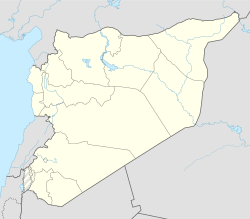Al-Sarkha (Bakhah)
Al-Sarkha
ܒܟܥܐ - בכעא الصرخة, بخعة | |
|---|---|
Village | |
| Coordinates: 33°53′4″N 36°33′46″E / 33.88444°N 36.56278°E | |
| Country | |
| Governorate | Rif Dimashq Governorate |
| District | Yabroud District |
| Nahiyah | Yabroud |
| Population (2004 census)[1] | |
• Total | 1,405 |
| Time zone | UTC+2 (EET) |
| • Summer (DST) | UTC+3 (EEST) |
Al-Sarkha, Bakhʽah or Bakh'a (Western Neo-Aramaic: ܒܟܥܐ - בכעא lit. 'to cry or to weep', Arabic: الصرخة or بخعة)[2] is a Syrian village in the Yabroud District of the Rif Dimashq Governorate. According to the Syria Central Bureau of Statistics (CBS), Al-Sarkha had a population of 1,405 in the 2004 census.[1] The village, inhabited by Sunni Muslims of Aramean descent, it was vastly damaged during the Syrian Civil War, and most of the inhabitants fled to other parts of Syria or to Lebanon as refugees.[3][4][5][6][7][8][9][10][11] It is one of the only three remaining villages where Western Neo-Aramaic is spoken, alongside Maaloula and Jubb'adin.
Following their conversion to Islam in the 18th century, the inhabitants of Bakh'a underwent a religious transformation, shifting from being exclusively Christian to entirely Muslim.[12][13]
References
[edit]- ^ a b General Census of Population and Housing 2004 Archived 2014-10-31 at the Wayback Machine. Syria Central Bureau of Statistics (CBS). Rif Dimashq Governorate.(in Arabic)
- ^ "English: Maaloula 7". 11 September 2017.
- ^ http://friendsofmaaloula.de/blog/2018/12/06/zerstoertes-bachaa-in-syrien/,"Dear friends of the Aramaean village of Maaloula, We received a heartbreaking video from Bacha‘a, the Aramaic neighboring village of Maaloula. Rebels attacked Maaloula from there, resulting in the complete destruction of the village. There is no life left, and all surviving residents have fled to relatives and friends in other parts of Syria or to Lebanon."
- ^ "The Village of Bakh'a in Qalamoun: Interview". 26 January 2020.
- ^ Rafik Schami (25 July 2011). Märchen aus Malula (in German). Carl Hanser Verlag GmbH & Company KG. p. 151. ISBN 9783446239005.
Ich kenne das Dorf nicht, doch gehört habe ich davon. Was ist mit Malula?‹ fragte der festgehaltene Derwisch. >Das letzte Dorf der Aramäer< lachte einer der…
- ^ Yaron Matras; Jeanette Sakel (2007). Grammatical Borrowing in Cross-Linguistic Perspective. De Gruyter. p. 185. doi:10.1515/9783110199192. ISBN 9783110199192.
The fact that nearly all Arabic loans in Ma'lula originate from the period before the change from the rural dialect to the city dialect of Damascus shows that the contact between the Aramaeans and the Arabs was intimate…
- ^ Dr. Emna Labidi (2022). Untersuchungen zum Spracherwerb zweisprachiger Kinder im Aramäerdorf Dschubbadin (Syrien) (in German). LIT. p. 133. ISBN 9783643152619.
Aramäer von Ǧubbˁadīn
- ^ Prof. Dr. Werner Arnold; P. Behnstedt (1993). Arabisch-aramäische Sprachbeziehungen im Qalamūn (Syrien) (in German). Harassowitz. p. 42. ISBN 9783447033268.
Die arabischen Dialekte der Aramäer
- ^ Prof. Dr. Werner Arnold; P. Behnstedt (1993). Arabisch-aramäische Sprachbeziehungen im Qalamūn (Syrien) (in German). Harassowitz. p. 5. ISBN 9783447033268.
Die Kontakte zwischen den drei Aramäer-dörfern sind nicht besonders stark.
- ^ Prof. Dr. Werner Arnold (2006). Lehrbuch des Neuwestaramäischen (in German). Harrassowitz. p. 133. ISBN 9783447053136.
Aramäern in Ma'lūla
- ^ Prof. Dr. Werner Arnold (2006). Lehrbuch des Neuwestaramäischen (in German). Harrassowitz. p. 15. ISBN 9783447053136.
Viele Aramäer arbeiten heute in Damaskus, Beirut oder in den Golfstaaten und verbringen nur die Sommermonate im Dorf.
- ^ Shannon Dubenion-Smith; Joseph Salmons (15 August 2007). Historical Linguistics 2005. John Benjamins Publishing Company. p. 247. ISBN 9789027292162.
…Western Neo-Aramaic (Spitaler 1938; Arnold 1990), which is attested in three villages whose speakers just a few generations ago were still entirely Christian.
- ^ Wolfhart Heinrichs (14 August 2018). Studies in Neo-Aramaic. Brill. p. 11. ISBN 9789004369535.
The inhabitants of Bakh'a and Jubb'Adin are Muslims (since the eighteenth century), as is a large portion of the people of Ma'lula, while the rest have remained Christian, mostly of Melkite (Greek Catholic) persuasion. The retention of the "Christian" language after conversion to Islam is noteworthy.
Bibliography
[edit]External links
[edit]- Samples of spoken Western Neo-Aramaic at the Semitisches Tonarchiv (Semitic Audio Archive)



